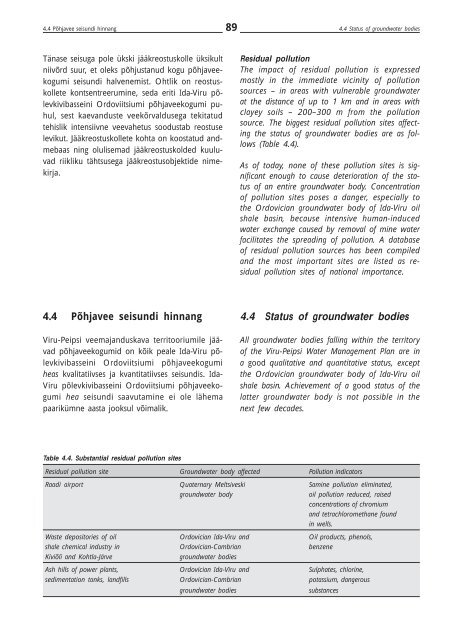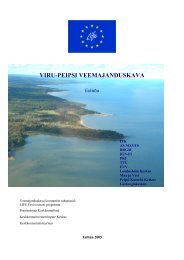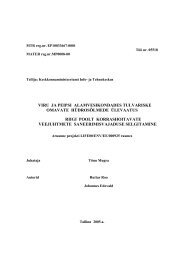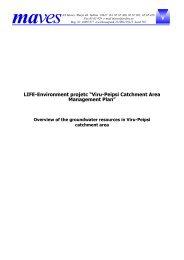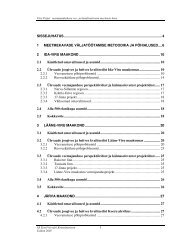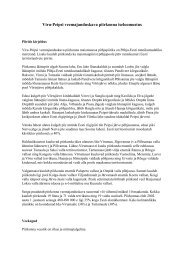Viru-Peipsi veemajanduskava - Keskkonnaministeerium
Viru-Peipsi veemajanduskava - Keskkonnaministeerium
Viru-Peipsi veemajanduskava - Keskkonnaministeerium
Create successful ePaper yourself
Turn your PDF publications into a flip-book with our unique Google optimized e-Paper software.
89<br />
4.4 Põhjavee seisundi hinnang 4.4 Status of groundwater bodies<br />
Tänase seisuga pole ükski jääkreostuskolle üksikult<br />
niivõrd suur, et oleks põhjustanud kogu põhjaveekogumi<br />
seisundi halvenemist. Ohtlik on reostuskollete<br />
kontsentreerumine, seda eriti Ida-<strong>Viru</strong> põlevkivibasseini<br />
Ordoviitsiumi põhjaveekogumi puhul,<br />
sest kaevanduste veekõrvaldusega tekitatud<br />
tehislik intensiivne veevahetus soodustab reostuse<br />
levikut. Jääkreostuskollete kohta on koostatud andmebaas<br />
ning olulisemad jääkreostuskolded kuuluvad<br />
riikliku tähtsusega jääkreostusobjektide nimekirja.<br />
Residual pollution<br />
The impact of residual pollution is expressed<br />
mostly in the immediate vicinity of pollution<br />
sources – in areas with vulnerable groundwater<br />
at the distance of up to 1 km and in areas with<br />
clayey soils – 200–300 m from the pollution<br />
source. The biggest residual pollution sites affecting<br />
the status of groundwater bodies are as follows<br />
(Table 4.4).<br />
As of today, none of these pollution sites is significant<br />
enough to cause deterioration of the status<br />
of an entire groundwater body. Concentration<br />
of pollution sites poses a danger, especially to<br />
the Ordovician groundwater body of Ida-<strong>Viru</strong> oil<br />
shale basin, because intensive human-induced<br />
water exchange caused by removal of mine water<br />
facilitates the spreading of pollution. A database<br />
of residual pollution sources has been compiled<br />
and the most important sites are listed as residual<br />
pollution sites of national importance.<br />
4.4 Põhjavee seisundi hinnang<br />
<strong>Viru</strong>-<strong>Peipsi</strong> <strong>veemajanduskava</strong> territooriumile jäävad<br />
põhjaveekogumid on kõik peale Ida-<strong>Viru</strong> põlevkivibasseini<br />
Ordoviitsiumi põhjaveekogumi<br />
heas kvalitatiivses ja kvantitatiivses seisundis. Ida-<br />
<strong>Viru</strong> põlevkivibasseini Ordoviitsiumi põhjaveekogumi<br />
hea seisundi saavutamine ei ole lähema<br />
paarikümne aasta jooksul võimalik.<br />
4.4 Status of groundwater bodies<br />
All groundwater bodies falling within the territory<br />
of the <strong>Viru</strong>-<strong>Peipsi</strong> Water Management Plan are in<br />
a good qualitative and quantitative status, except<br />
the Ordovician groundwater body of Ida-<strong>Viru</strong> oil<br />
shale basin. Achievement of a good status of the<br />
latter groundwater body is not possible in the<br />
next few decades.<br />
Table 4.4. Substantial residual pollution sites<br />
Residual pollution site Groundwater body affected Pollution indicators<br />
Raadi airport Quaternary Meltsiveski Samine pollution eliminated,<br />
groundwater body<br />
oil pollution reduced, raised<br />
concentrations of chromium<br />
and tetrachloromethane found<br />
in wells.<br />
Waste depositories of oil Ordovician Ida-<strong>Viru</strong> and Oil products, phenols,<br />
shale chemical industry in Ordovician-Cambrian benzene<br />
Kiviõli and Kohtla-Järve<br />
groundwater bodies<br />
Ash hills of power plants, Ordovician Ida-<strong>Viru</strong> and Sulphates, chlorine,<br />
sedimentation tanks, landfills Ordovician-Cambrian potassium, dangerous<br />
groundwater bodies<br />
substances


